
Saludos, comunidad. El día de hoy quisiera darles una enseñanza como odontólogo. Mi intención es que podamos aclarar de manera sencilla algunas inquietudes y términos que en la consulta suelen ser de desconocimiento total, es por ello que pienso que todos deberían saber está información, ya que son nuestros dientes los que se ven afectados la mayoría de las veces.
Diariamente, veo situaciones de pacientes que por desconocimiento dañan su dentadura. En la labor de odontólogo se pueden ver muchas cosas, como pacientes que no se cepillan correctamente o simplemente no lo hacen, algunos que tienen procesos cariogénicos "caries muy avanzadas”, por lo que, al no tener dolor, aprenden a vivir con esas manchas negras. Sin duda es un tema de mucha importancia, ya que esa misma ignorancia se está transmitiendo a las generaciones más pequeñas. En estos tiempos, es más común ver a niños que nunca se han cepillado, o peor, niños sin dientes a una edad muy temprana. Mediante este escrito quiero que entiendan un poco y puedan hacer conciencia sobre este tema.
Primero que todo, debemos saber que el diente se divide en tres zonas. Corona, cuello y raíz. Cada diente tiene un nervio que le da irrigación, es decir, tienen un corazón y sin él, los dientes tienden a fracturarse y a ponerse de color opaco. A este corazón se le llama pulpa dentaria.
Greetings, community. Today I would like to give you a teaching as a dentist. My intention is that we can clarify in a simple way some concerns and terms that in the practice are often of total ignorance, which is why I think that everyone should know this information, since it is our teeth that are affected most of the time.
Every day, I see situations where patients damage their teeth due to lack of knowledge. In the work of a dentist you can see many things, such as patients who do not brush properly or simply do not do it, some who have cariogenic processes "very advanced caries", so that, having no pain, they learn to live with these black spots. Undoubtedly, this is a very important issue, since that same ignorance is being transmitted to the younger generations. These days, it is more common to see children who have never brushed, or worse, children without teeth at a very young age. Through this writing I want you to understand a little and raise awareness about this issue.
First of all, we must know that the tooth is divided into three zones. Crown, neck and root. Each tooth has a nerve that gives it irrigation, that is to say, they have a heart and without it, the teeth tend to fracture and become opaque. This heart is called dental pulp.
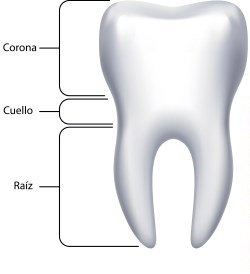
Caries
Es la patología más común en los pacientes, las caries se forman por acumulación de bacterias y éstas cambian el color del diente. Durante su proceso de afectación, suelen ir de marrón claro (cuando están naciendo), hasta negro mate (cuando ya están en su última fase). Pueden estar en cualquier superficie del diente y su tamaño es gradual. Algo que debemos saber es que siempre irá en aumento, las caries no desaparecen al menos que sean tratadas de manera clínica.
"En los últimos años se han inventado nuevos medicamentos para poder eliminar las caries, pero estos solo se usan en su fase temprana".
cavities
It is the most common pathology in patients, cavities are formed by accumulation of bacteria and these change the color of the tooth. During their process of affectation, they usually go from light brown (when they are emerging) to matte black (when they are already in their last phase). They can be on any surface of the tooth and their size is gradual. Something we should know is that it will always increase, cavities do not disappear unless they are treated clinically.
"In recent years, new medications have been invented to eliminate cavities, but they are only used in their early stages".
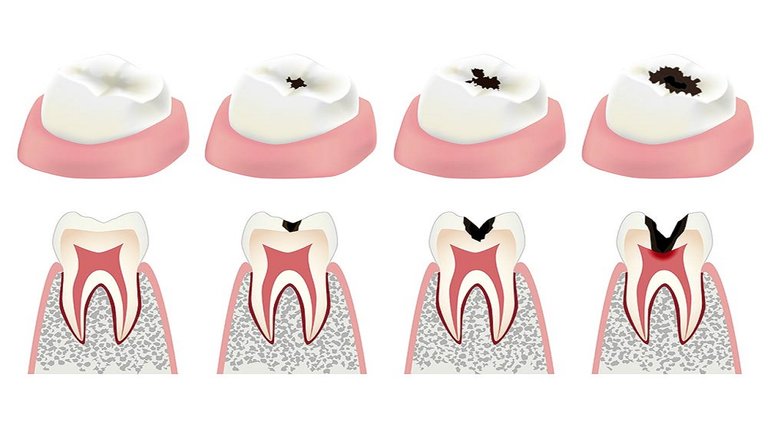
Restauraciones
Ya sabiendo que es una carie, vamos a entender cómo y con qué material se elimina y restaura. Las caries se eliminan con un instrumento llamado turbina, está elimina las caries de manera física mediante rotación. Al eliminar una carie se crea un agujero y este debe ser rellenado con un material específico.
A lo largo de la historia han existido distintos tipos de materiales de restauración, siendo el más importante: la resina, un material de color idéntico al diente. Sin duda a niveles evolutivos es un salto grande, ya que su predecesor, la amalgama, era un material metálico sin estética y con muchas desventajas.
En la actualidad, es normal ver dientes restaurados hasta con más belleza y definición que un diente natural.
Es importante saber que las únicas maneras de restauración dental, deben ser tratadas por un especialista, ya que existen muchos remedios caseros que normalmente pueden hasta quitar el dolor pero empeoran la situación.
Restorations
Now that we know what a cavity is, let's understand how and with what material it is removed and restored. Cavities are removed with an instrument called a turbine, which physically removes cavities by rotation. When a cavity is removed, a hole is created and this hole must be filled with a specific material.
Throughout history there have been different types of restorative materials, the most important being: resin, a tooth-identical colored material. This is undoubtedly a great leap forward in terms of evolution, since its predecessor, amalgam, was a metallic material without esthetics and with many disadvantages.
Nowadays, it is normal to see restored teeth with even more beauty and definition than a natural tooth.
It is important to know that the only ways of dental restoration should be treated by a specialist, since there are many home remedies that usually can even remove the pain but worsen the situation.
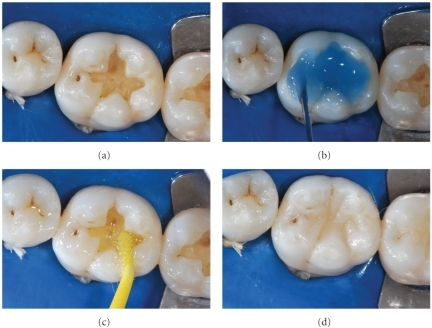
¿Qué pasa cuando una carie no se trató a tiempo?
Las caries pueden avanzar en boca de manera rápida y descomunal. Al afectar un diente, pueden llegar a "matar" a este mismo, afectando la pulpa dentaria (corazón). En este caso solo hay dos tratamientos:
- Extracción del diente
Sin ninguna duda la extracción dentaria es la última opción, aun así perder una pieza es muy grave para el paciente y a largo plazo puede traer problemas de mal posiciones dentarias o modificación de la mordida natural de un paciente. Deben entender que cada diente tiene una función, si eliminamos un diente sobrecargamos a los demás con la función que este realizaba, por ende, los exponemos a desgastes mayores e incluso pueden causar fracturas. Por esas razones debemos evitar a toda costa la extracción.
- Endodoncia o " tratamiento de conducto"
En este tratamiento suele existir mucha confusión, ya que no es algo que nos enseñen en la primaria. Este tratamiento, consiste en eliminar la pulpa dentaria (corazón del diente) y sustituirlo con un material que le dé fuerza al diente, ya que al no tener corazón, como dije antes pierde propiedades y puede fracturarse. Este material le da resistencia y permite mantener al diente en boca.
Mi recomendación como odontólogo, es que este tratamiento complejo lo realice un especialista para tener mayor margen de éxito.
What happens when a cavity is not treated in time?
Cavities can advance in the mouth in a fast and huge way. When they affect a tooth, they can even "kill" it, affecting the dental pulp (heart). In this case there are only two treatments:
Tooth extraction
Without any doubt tooth extraction is the last option, even so losing a piece is very serious for the patient and in the long term can bring problems of bad dental positions or modification of the natural bite of a patient. You must understand that each tooth has a function, if we remove a tooth we overload the other teeth with the function it performed, therefore, we expose them to greater wear and may even cause fractures. For these reasons we must avoid extraction at all costs.
Endodontics or "root canal treatment"
In this treatment there is usually a lot of confusion, since it is not something that we are taught in elementary school. This treatment consists of removing the dental pulp (heart of the tooth) and replacing it with a material that gives strength to the tooth, since not having a heart, as I said before, it loses properties and can fracture. This material gives strength and allows the tooth to remain in the mouth.
My recommendation as a dentist is that this complex treatment should be performed by a specialist in order to have a greater margin of success.
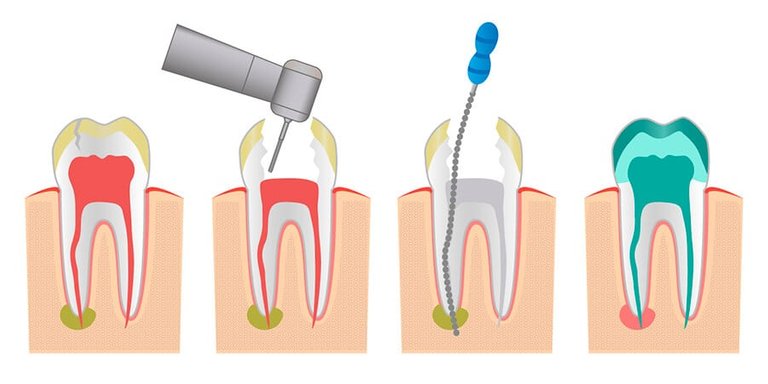
¿Cómo evitar las caries?
El mejor tratamiento para evitar los procesos cariogénicos, es el buen cepillado 3 veces al día y el uso del enjuague bucal. Se debe crear un hábito del cepillado, para que de esta manera, disminuya la posibilidad de que se forme un proceso cariogénicos, es importante visitar a su odontólogo cada 6 meses para una consulta y limpieza de rutina.
How to avoid cavities?
The best treatment to avoid caries is good brushing 3 times a day and the use of mouthwash. You must create a habit of brushing, so that in this way, reduce the possibility of forming a cariogenic process, it is important to visit your dentist every 6 months for a consultation and routine cleaning.
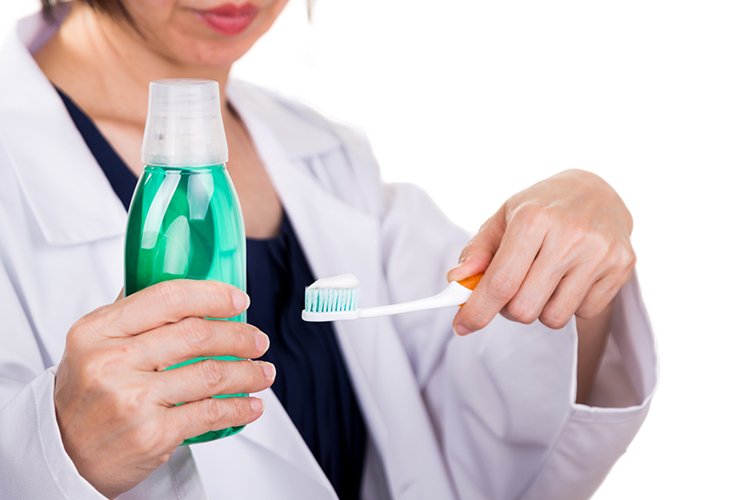
Dentro de la cavidad bucal, existen miles de patologías, siendo las "caries" la más común y la de menos conocimiento. Es por eso, que con esta pequeña guía espero que puedan entender y conozcan más de sus dientes. Poco a poco iré subiendo más guías como esta, para que así aprendan y puedan aplicarlos en sus vidas diarias. Espero que lo hayan disfrutado.
¡Hasta la próxima!
Within the oral cavity, there are thousands of pathologies, being "caries" the most common and the least known. That is why, with this small guide I hope you can understand and know more about your teeth. Little by little I will be uploading more guides like this one, so you can learn and apply them in your daily lives. I hope you enjoyed it.
See you next time!

- The cover of this publication was made in canva in its free version.
- The text has been translated by Deepl in its free version.
Congratulations @adamcero! You have completed the following achievement on the Hive blockchain and have been rewarded with new badge(s):
Your next target is to reach 50 upvotes.
You can view your badges on your board and compare yourself to others in the Ranking
If you no longer want to receive notifications, reply to this comment with the word
STOPTo support your work, I also upvoted your post!
Check out the last post from @hivebuzz:
Support the HiveBuzz project. Vote for our proposal!